Torrieri D. Principles of Spread-Spectrum Communication Systems
Подождите немного. Документ загружается.


418
APPENDIX C.
S
IGNAL CHARACTERISTICS
Let and let Equations (C-l) and (C-4) and
the convolution theorem imply that
Because results from passing through two successive filters, each
with transfer function
provided that G(0) = 0.
Equation (C-6) indicates that taking the Hilbert transform corresponds to
introducing a phase sift of radians for all positive frequencies and radians
for all negative frequencies. Consequently,
These relations can be formally verified by taking the Fourier transform of the
left-hand side of (C-8) or (C-9), applying (C-6), and then taking the inverse
Fourier transform of the result. If for and the same
method yields
A bandpass signal is one with a Fourier transform that is negligible except
for where and is the center
frequency. If the bandpass signal is often called a narrowband signal.
A complex-valued signal with a Fourier transform that is nonzero only for
is called an analytic signal.
Consider a bandpass signal with Fourier transform The ana-
lytic signal associated with is defined to be the signal with Fourier
transform
which is zero for and is confined to the band when
The inverse Fourier transform of (C-12) and (C-6) imply that
The complex envelope of is defined by
where is the center frequency if is a bandpass signal. Since the Fourier
transform of is which occupies the band the complex
envelope is a baseband signal that may be regarded as an equivalent lowpass

C.2. STATIONARY STOCHASTIC PROCESSES
419
representation of Equations (C-13) and (C-14) imply that may be
expressed in terms of its complex envelope as
The complex envelope can be decomposed as
where and are real-valued functions. Therefore, (C-15) yields
Since the two sinusoidal carriers are in phase quadrature, and are
called the in-phase and quadrature components of respectively. These
components are lowpass signals confined to
Applying Parseval’s identity from Fourier analysis and then (C-6), we obtain
Therefore,
where denotes the energy of the bandpass signal
C.2
Stationary Stochastic Processes
Consider a stochastic process that is a zero-mean, wide-sense stationary
process with autocorrelation
where denotes the expected value of The Hilbert transform of this
process is the stochastic process defined by
where it is assumed that the Cauchy principal value of the integral exists for
almost every sample function of This equation indicates that is a
zero-mean stochastic process. The zero-mean processes and are jointly
wide-sense stationary if their correlation and cross-correlation functions are not

420
APPENDIX C. SIGNAL CHARACTERISTICS
functions of A straightforward calculation using (C-21) and (C-20) gives the
cross correlation
A similar derivation using (C-7) yields the autocorrelation
Equations (C-20), (C-22), and (C-23) indicate that and are jointly
wide-sense stationary.
The analytic signal associated with is the zero-mean process defined by
The autocorrelation of the analytic signal is defined as
where thee asterisk denotes the complex conjugate. Using (C-20) and (C-22)
which establishes the wide-sense stationarity of the analytic signal.
Since (C-20) indicates that is an even function, (C-22) yields
which indicates that and are uncorrelated. Equations (C-23), (C-26),
and (C-27) yield
The complex envelope of or the equivalent lowpass representation of
is the zero-mean stochastic process defined by
where is an arbitrary frequency usually chosen as the center or carrier fre-
quency of The complex envelope can be decomposed as
where and are real-valued, zero-mean stochastic processes.
Equations (C-29) and (C-30) imply that
Substituting (C-24) and (C-30) into (C-29) we find that
to (C-25), we obtain
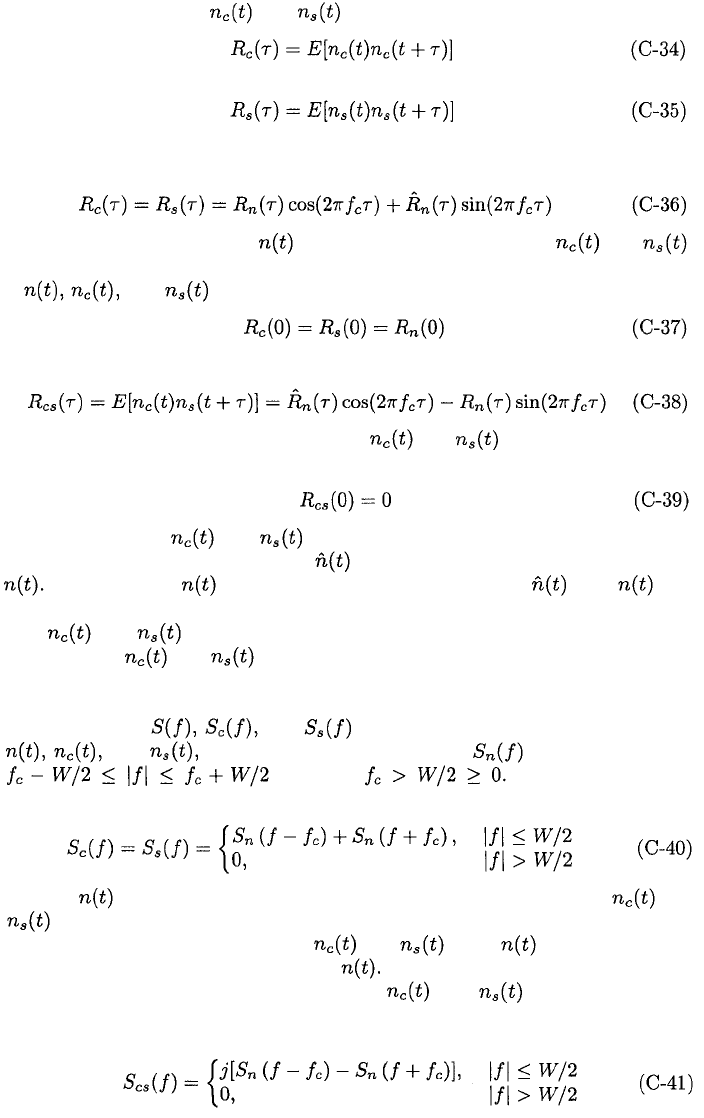
C.2. STATIONARY STOCHASTIC PROCESSES
421
The autocorrelations of and are defined by
and
Using (C-32) and (C-33) and then (C-20), (C-23), and (C-24) and trigonometric
identities, we obtain
which shows explicitly that if is wide-sense stationary, then and
are wide-sense stationary with the same autocorrelation function. The variances
of and are all equal because
A derivation similar to that of (C-36) gives the cross correlation
Equations (C-36) and (C-38) indicate that and are jointly wide-sense
stationary. Equations (C-28) and (C-38) give
which implies that and are uncorrelated.
Equation (C-21) indicates that is generated by a linear operation on
Therefore, if is a zero-mean Gaussian process, and are
zero-mean jointly Gaussian processes. Equations (C-32) and (C-33) then imply
that and are zero-mean jointly Gaussian processes. Since they are
uncorrelated, and are statistically independent, zero-mean Gaussian
processes.
The power spectral density of a signal is the Fourier transform of its auto-
correlation. Let and denote the power spectral densities of
and respectively. We assume that occupies the band
and that Taking the Fourier
transform of (C-36), using (C-6), and simplifying, we obtain
Thus, if is a passband process with one-sided bandwidth W, then and
are baseband processes with one-sided bandwidths W/2. This property
and the statistical independence of and when is Gaussian make
(C-31) a very useful representation of
Similarly, the cross-spectral density of and can be derived by
taking the Fourier transform of (C-38) and using (C-6). After simplification,
the result is
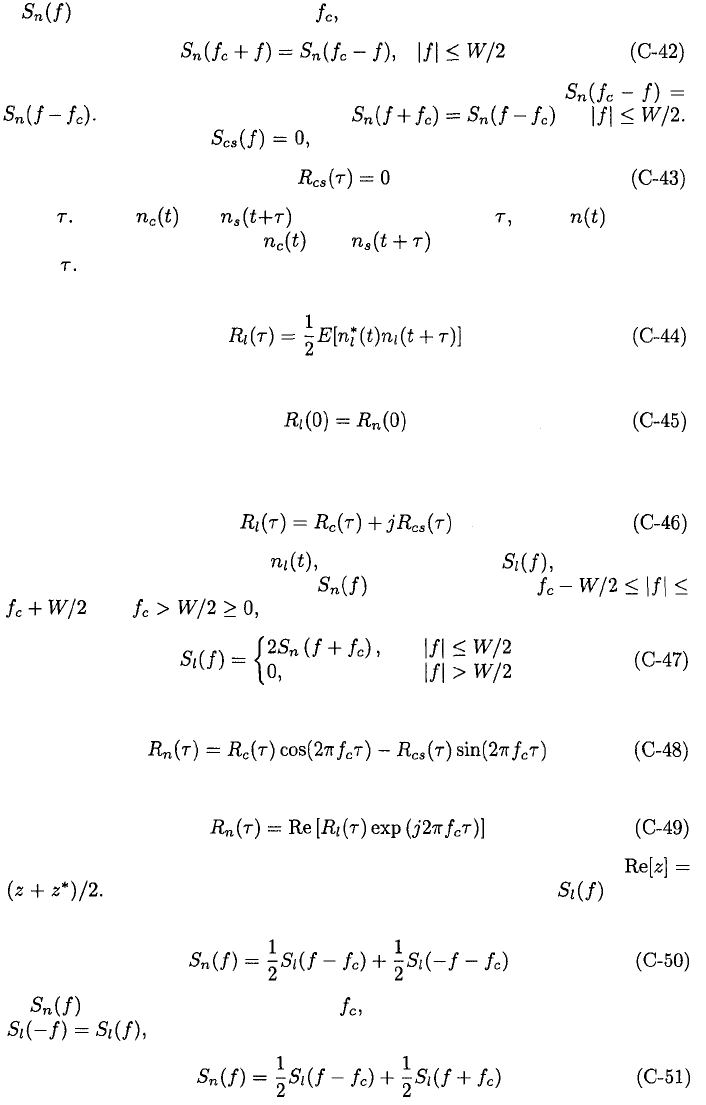
422
APPENDIX C. SIGNAL CHARACTERISTICS
If is locally symmetric about then
Since a power spectral density is a real-valued, even function,
Equation (C-42) then yields for
Therefore, (C-41) gives which implies that
for all Thus, and are uncorrelated for all and if is a zero-
mean Gaussian process, then and are statistically independent
for all
The autocorrelation of the complex envelope is defined by
where the 1/2 is inserted so that
which follows from (C-28) and (C-29). Substituting (C-30) into (C-44) and
using (C-36) and (C-38), we obtain
The power spectral density of which we denote by can be derived
from (C-46), (C-41), and (C-40). If occupies the band
and then
Equations (C-36) and (C-38) yield
Equations (C-48) and (C-46) imply that
We expand the right-hand side of this equation by using the fact that
Taking the Fourier transform and observing that is a real-
valued function, we obtain
If is locally symmetric about then (C-47) and (C-42) imply that
and (C-50) becomes
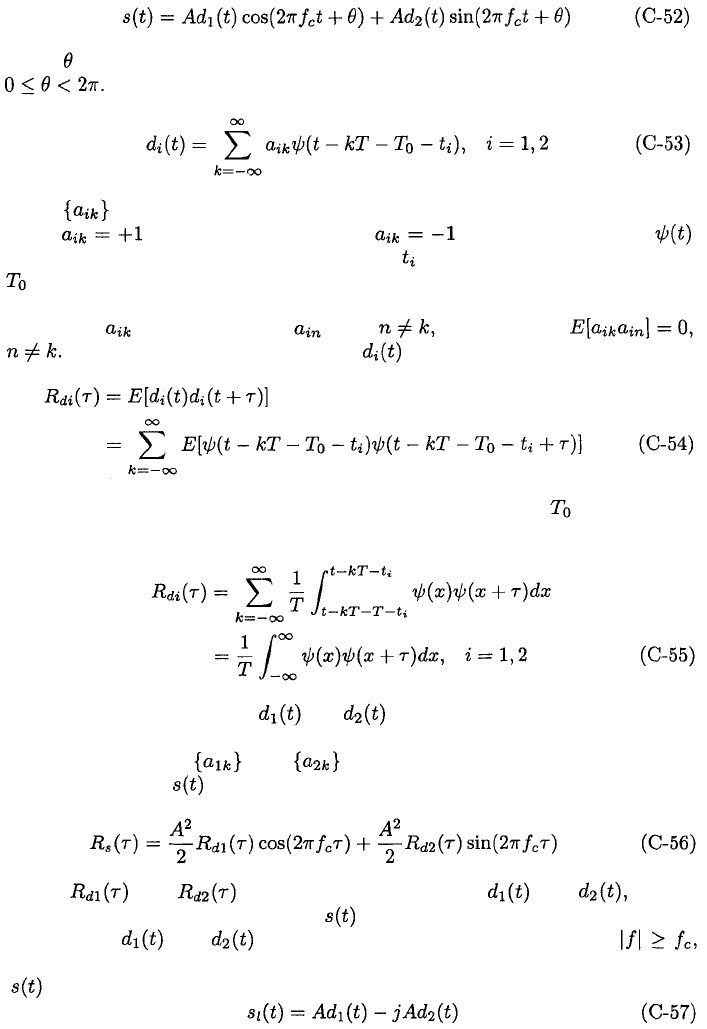
C.2. STATIONARY STOCHASTIC PROCESSES
423
Power Spectral Densities of Communication Signals
Many useful communication signals are modeled as having the form
where is an independent random variable that is uniformly distributed over
The modulations have the form
where is a sequence of independent, identically distributed random vari-
ables, with probability 1/2 and with probability 1/2,
is a pulse waveform, T is the pulse duration, is the relative pulse offset, and
is an independent random variable that is uniformly distributed over the
interval (0, T) and reflects the arbitrariness of the origin of the coordinate sys-
tem. Since is independent of when it follows that
Therefore, the autocorrelation of is
Expressing the expected value as an integral over the range of and changing
variables, we obtain
This equation indicates that and are wide-sense stationary processes
with the same autocorrelation.
If the sequences and are statistically independent, then the
autocorrelation of is
where and are the autocorrelations of and respec-
tively. This equation indicates that is wide-sense stationary. If the sample
functions of and have Fourier transforms that vanish for
then (C-10), (C-11), (C-24), and (C-29) indicate that the complex envelope of
is
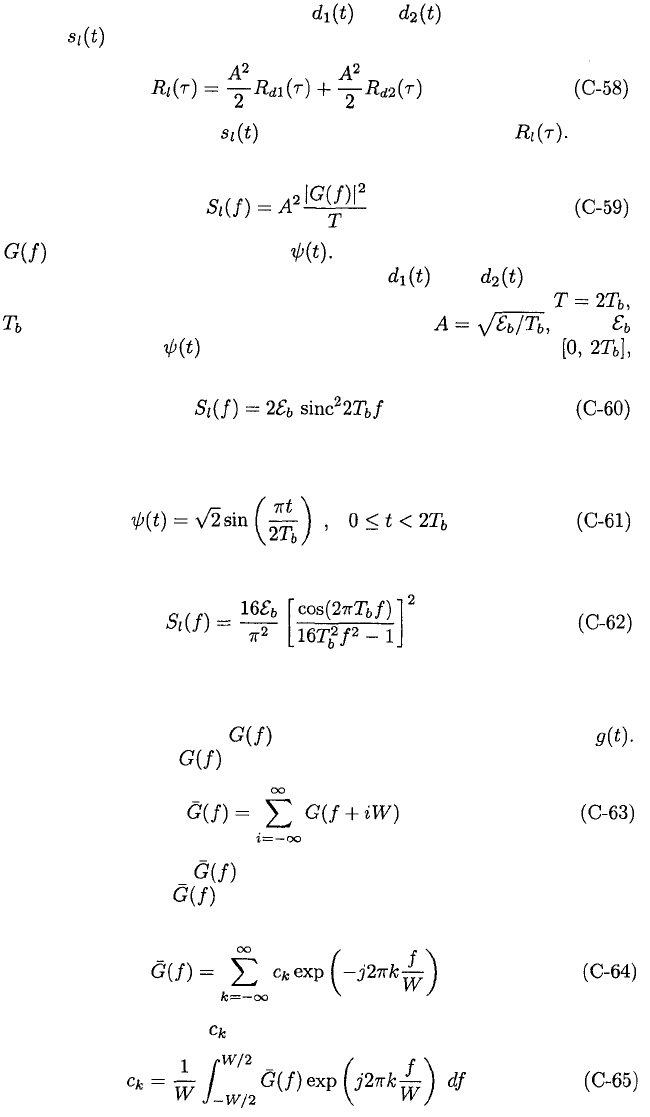
424
APPENDIX C. SIGNAL CHARACTERISTICS
Equation (C-44) and the independence of and imply that the auto-
correlation of is
The power spectral density of is the Fourier transform of From
(C-58) and (C-55), we obtain the density
where is the Fourier transform of
In a quadriphase-shift-keying (QPSK) signal, and are usually
modeled as independent random binary sequences with pulse duration
where is a bit duration. The component amplitude is where
is the energy per bit. If is rectangular with unit amplitude over
then (C-59) yields the power spectral density for QPSK:
which is the same as the density for PSK. For a binary minimum-shift-keying
(MSK) signal with the same component amplitude,
Therefore, the power spectral density for MSK is
C.3
Sampling Theorems
Consider the Fourier transform of an absolutely integrable function
The periodic extension of is defined as
where W is the period of and it is assumed that the series converges
uniformly. Suppose that has a piecewise continuous derivative so that it
can be represented as a uniformly convergent complex Fourier series:
where the Fourier coefficient is given by
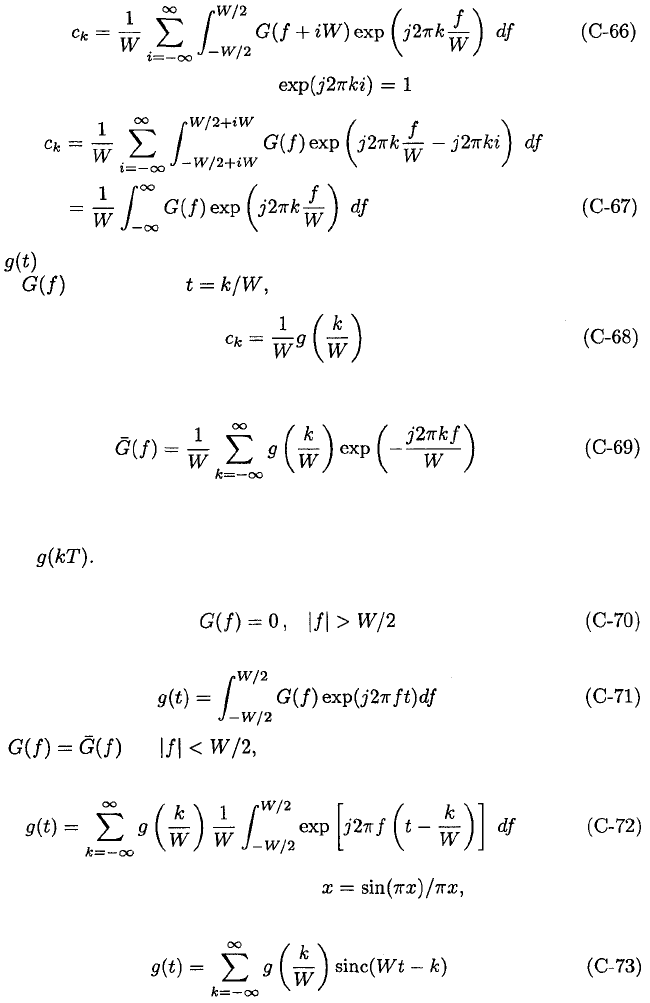
C.3. SAMPLING THEOREMS
425
Substituting (C-63) into (C-65) and interchanging the order of the summation
and the integration, which is justified because of the uniform convergence, we
obtain
We change variables and observe the to obtain
Since is absolutely integrable, the last integral is the inverse Fourier trans-
form of evaluated at and
Substituting (C-68) into (C-64) yields one version of the Poisson sum formula:
where the series converges uniformly. If we define T = 1/W, then the right-
hand side of (C-69) is proportional to the discrete-time Fourier transform of the
sequence
Suppose that the Fourier transform vanishes outside a frequency band:
It follows that
Since for (C-71) and (C-69) and the interchange of a
summation and integration yield
Evaluating this integral and defining sinc we obtain the sam-
pling theorem for deterministic signals:
where the samples are separated by T = 1/W.

426
APPENDIX C. SIGNAL CHARACTERISTICS
Consider a wide-sense stationary stochastic process with autocorrela-
tion and power spectral density which is the Fourier transform of
then it follows from the sampling theorem that
For an arbitrary constant the Fourier transform of is
which is zero for Therefore, (C-75) can be applied to
which gives
We define the stochastic process
The mean square difference between and is
Since the repeated use of (C-76) yields
which states that the mean square difference between and approaches
zero. With equality interpreted in the sense of this limit, the sampling theorem
for stationary stochastic process is
C.4
Direct-Conversion Receiver
Receivers often extract the complex envelope of the desired signal before apply-
ing it to a matched filter. The main components in a direct-conversion receiver
If
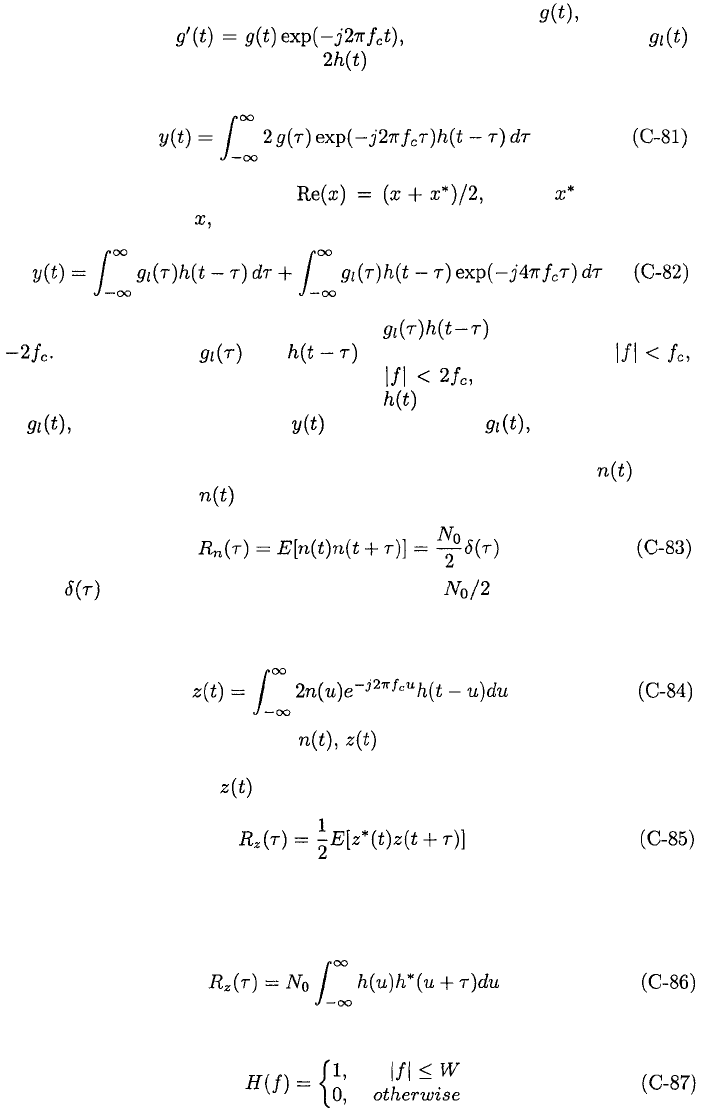
C.4.
DIRECT-CONVERSION RECEIVER
427
are shown in Figure C.1(a). The spectra of the received signal the input to
the baseband filter and the complex envelope
are depicted in Figure C.1(b). Let denote the impulse response of the
filter. The output of the filter is
Using (C-15) and the fact that where denotes the
complex conjugate of we obtain
The second term is the Fourier transform of evaluated at frequency
Assuming that and have transforms confined to
their product has a transform confined to and the second term in
(C-82) vanishes. If the Fourier transform of is a constant over the passband
of then (C-82) implies that is proportional to as desired. Figure
C.1(c) shows the direct-conversion receiver for real-valued signals.
The direct-conversion receiver alters the character of the noise enter-
ing it. Suppose that is a zero-mean, white Gaussian noise process with
autocorrelation
where denotes the Dirac delta function, and is the two-sided noise-
power spectral density. The complex-valued noise at the output of Figure C.1 (a)
is
Since it is a linear function of is zero-mean and its real and imagi-
nary parts are jointly Gaussian. The autocorrelation of a wide-sense stationary,
complex-valued process is defined as
Substituting (C-84), interchanging the expectation and integration operations,
using (C-83) to evaluate one of the integrals, and then changing variables, we
obtain
If the filter is an ideal bandpass filter with Fourier transform
